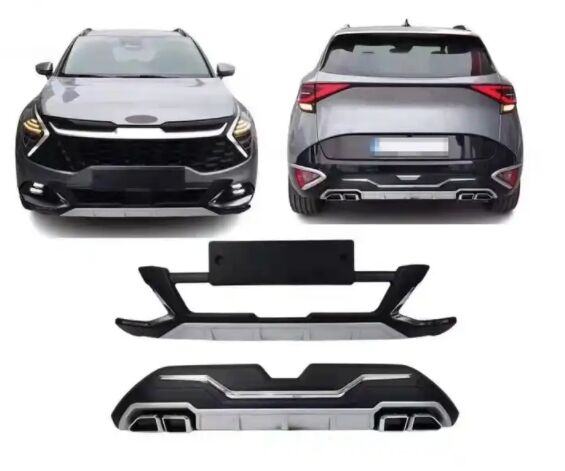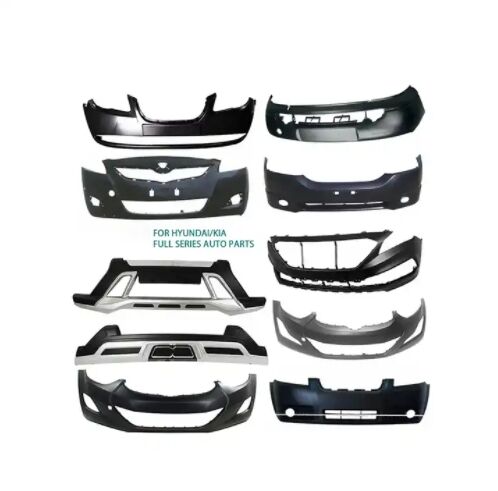Osnovni vodič za odabir savršenog stražnjeg branika
Kada je riječ o zaštiti i poboljšanju vašeg vozila, odabir pravog zadnji bumpar igra ključnu ulogu u funkcionalnosti i estetici. Stražnji branik služi kao više nego samo zaštitna prepreka – to je ključni sastavni dio koji doprinosi ukupnom izgledu, sigurnosti i performansama vašeg vozila. Bez obzira zamjenjujete li oštećeni branik ili ga nadograđujete radi poboljšanja sposobnosti vozila, razumijevanje ključnih čimbenika pri odabiru savršenog stražnjeg branika osigurat će vam donošenje informirane odluke koja zadovoljava vaše konkretne potrebe.
Razumijevanje materijala i konstrukcije stražnjeg branika
Mogućnosti stražnjeg branika od čelika
Čelični stražnji branici predstavljaju zlatni standard u trajnosti i zaštiti. Ove izdržljive komponente izrađene su od visokokvalitetnog čelika, nudeći izuzetnu čvrstoću i otpornost na udarce. Moderni čelični stražnji branici često imaju prahokom po prevlaku ili specijalne završne slojeve koji sprečavaju rđu i koroziju, osiguravajući dug vijek trajanja čak i u teškim uvjetima. Iako mogu dodati više težine vašem vozilu, kompromis u pogledu zaštite i trajnosti čini ih popularnim izborom među entuzijastima vanjskih putova i onima koji prioritet daju sigurnosti vozila.
Prednosti aluminijumskih stražnjih branika
Za one koji traže lakšu alternativu ne žrtvovati snagu, aluminijumske stražnje odbojnice predstavljaju odličnu opciju. Ove odbojnice obično imaju 40–60% manju težinu u odnosu na odbojnice od čelika, a pritom zadržavaju izuzetnu izdržljivost. Prirodna otpornost aluminijuma na koroziju čini ove odbojnice posebno pogodnim za upotrebu u obalnim područjima ili regijama sa teškim zimskim uslovima. Pored toga, aluminijumske stražnje odbojnice se mogu završiti na različite načine kako bi se postigli različiti estetski efekti, a da pritom ostanu zaštitna svojstva sačuvana.
Plastični i kompozitni materijali
Savremene stražnje odbojnice od plastike i kompozitnih materijala koriste napredne polimere i tehnike proizvodnje kako bi postigle izuzetan učinak. Ovi materijali nude odlično upijanje udaraca i znatno su lakši u odnosu na metalne alternative. Takođe su obično jeftiniji i lakši za zamenu. Međutim, u ekstremnim uslovima ili u terenskim situacijama, oni možda ne nude isti nivo zaštite kao metalne odbojnice.

Razmatranja u vezi s dizajnom vašeg vozila
Stil i estetika
Vizualni utjecaj stražnjeg branitelja može drastično promijeniti izgled vašeg vozila. Savremeni dizajni stražnjih branitelja kreću se od elegantnih, stilova poput fabričkih do čvrstih opcija pripremljenih za vožnju van ceste s integriranim značajkama. Razmislite kako dizajn branitelja dopunjava ukupni izgled vašeg vozila, uz istovremeno zadovoljenje vaših praktičnih potreba. Mnogi proizvođači nude mogućnosti personalizacije, uključujući različite završne obrade, teksture i dekorativne dijelove koji mogu pomoći u postizanju željenog izgleda.
Funkcionalnost i značajke
Iza osnovne zaštite, savremeni stražnji branici često uključuju različite funkcionalne značajke. To može uključivati ugrađene stepenice za lakši pristup teretu, tačke za vuču vozila, kompatibilnost sa senzorima za vožnju unazad i mjesta za ugradnju pomoćnih svjetala ili drugih dodataka. Razmislite koje značajke odgovaraju načinu upotrebe vašeg vozila i vašim potrebama. Neki stražnji branici također imaju podesive komponente koje se mogu mijenjati u skladu s određenim aktivnostima ili uvjetima.
Faktori performansi i sigurnosti
Standardi zaštitne otpornosti na udar
Kada birate stražnji branik, razumijevanje ocjena sigurnosti i sposobnosti zaštite od udaraca ključno je. Kvalitetni stražnji branici trebaju zadovoljavati ili premašivati savezne standarde sigurnosti, pružajući istovremeno povećanu zaštitu za važne komponente vašeg vozila. Potražite proizvode koji su prošli strog testiranja i certifikacijske procese kako biste bili sigurni da će se ponašati onako kako su predviđeni u slučajevima sudara. Razmotrite branike s zonama stiskanja ili dizajnima koji apsorbiraju energiju, a koji pomažu u smanjenju oštećenja vašeg vozila tijekom udaraca.
Težina i dinamika vozila
Težina odabranog stražnjeg branika može značajno utjecati na upravljanje vozilom, učinkovitost potrošnje goriva i ukupnu performansu. Teži čelični branici mogu zahtijevati prilagodbe ovjesa kako bi se održala pravilna ravnoteža vozila, dok lakši modeli pomažu u očuvanju izvornih voznih karakteristika vašeg vozila. Razmotrite najveću dopuštenu masu vozila (GVWR) i kako će težina branika utjecati na nosivost i potrošnju goriva.
Zahtjevi za montažom i održavanjem
Stručna ugradnja u usporedbi s ugradnjom vlastitim snagom
Ugradnja stražnjeg branitelja zahtijeva pažljivo razmatranje vaše tehničke sposobnosti i dostupnih alata. Dok su neki branitelji dizajnirani za jednostavnu ugradnju, drugi mogu zahtijevati prilagodbe ili specijaliziranu opremu. Stručna ugradnja osigurava pravilno uklađenje i funkcionalnost, posebno za složene dizajne s ugrađenim senzorima ili električnim komponentama. Uzmite u obzir troškove i zahtjeve ugradnje prilikom planiranja budžeta za novi stražnji branitelj.
Dugoročna njega i održavanje
Različiti materijali i završni slojevi stražnjih branitelja zahtijevaju različitu razinu održavanja kako bi očuvali svoj izgled i funkcionalnost. Čelični branitelji mogu zahtijevati redovnu provjeru rđe i dodatno bojanje, dok aluminijevi branitelji obično zahtijevaju manje intenzivnu njegu. Razmislite o klimatskim uvjetima kojima je vaše vozilo izloženo i odaberite branitelj čije zahtjeve za održavanje usklađene s vašom spremnošću i mogućnošću da redovno vršite održavanje.
Često postavljana pitanja
Kolika je prosječna životna trajnost stražnjeg branika?
Trajanje stražnjeg branika znatno varira ovisno o kvaliteti materijala, uvjetima korištenja i održavanju. Branici od visokokvalitetnog čelika ili aluminija mogu trajati cijeli vijek vašeg vozila uz odgovarajuće održavanje, dok plastični branici obično traju 5-7 godina prije nego što počnu pokazivati znakove degradacije ili zahtijevaju zamjenu.
Kako stražnji branik utječe na potrošnju goriva?
Utjecaj na potrošnju goriva ovisi prvenstveno o težini branika i aerodinamičkom dizajnu. Teški čelični branici mogu smanjiti učinkovitost potrošnje goriva za 1-3%, dok opcije od lakših materijala imaju minimalan utjecaj. Aerodinamični dizajni pomažu u smanjenju negativnih učinaka na potrošnju goriva.
Je li naknadno ugrađeni stražnji branik legalan u svim saveznim državama?
Iako su poluautomatski stražnji branici generalno legalni, propisi se razlikuju po državama u pogledu visine, širine i bezbednosnih karakteristika. Uvek proverite lokalne zakone o modifikaciji vozila i osigurajte da odabrani branik zadovoljava standarde bezbednosti i održava potrebne karakteristike poput vidljivosti registarske tablice i funkcionalnosti senzora.

